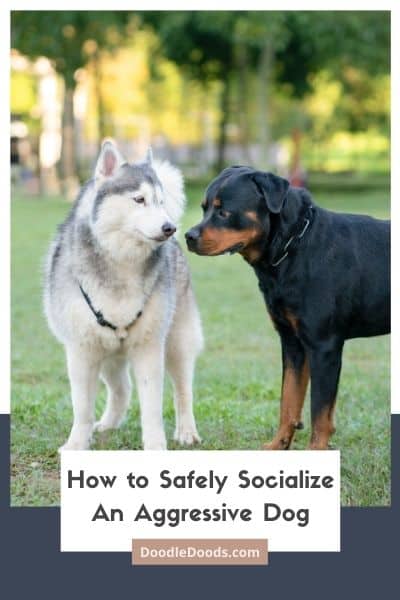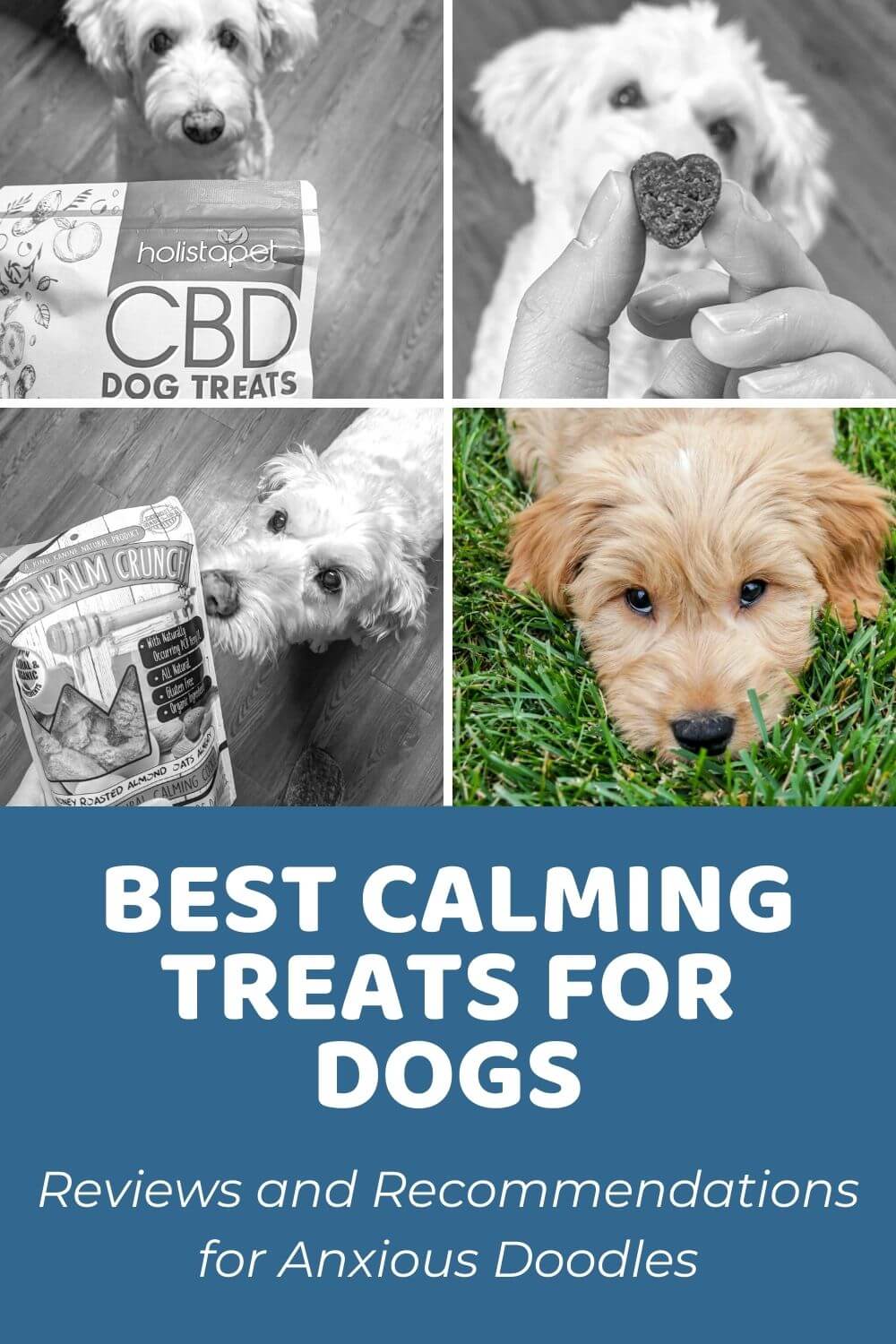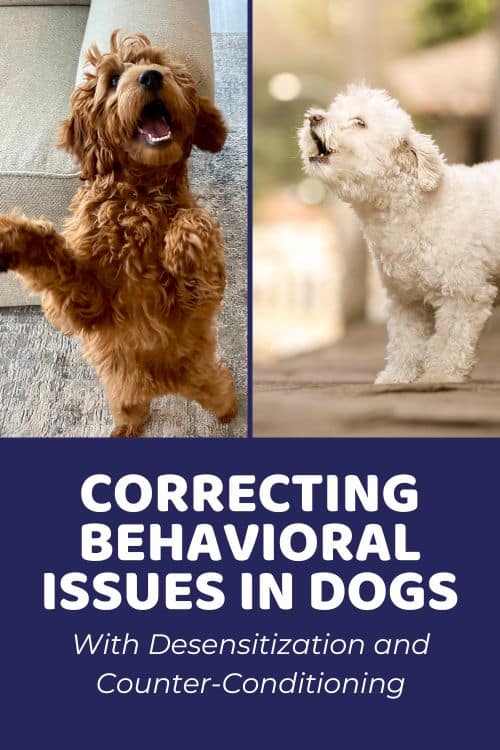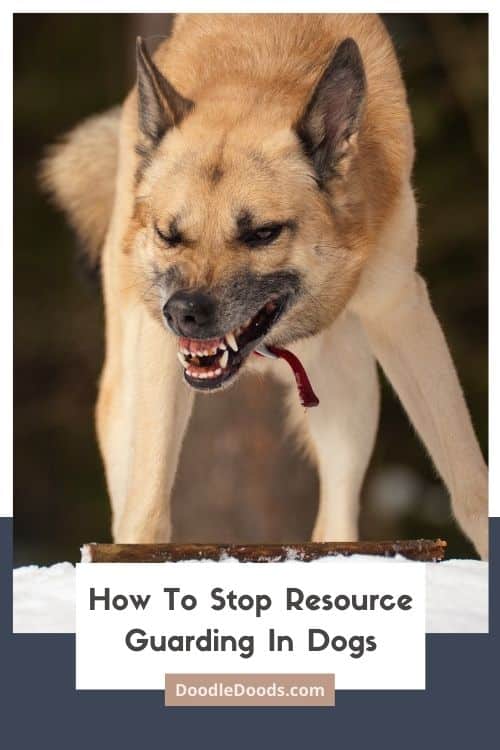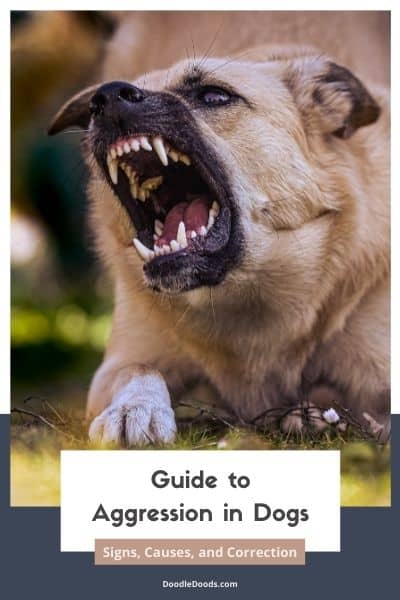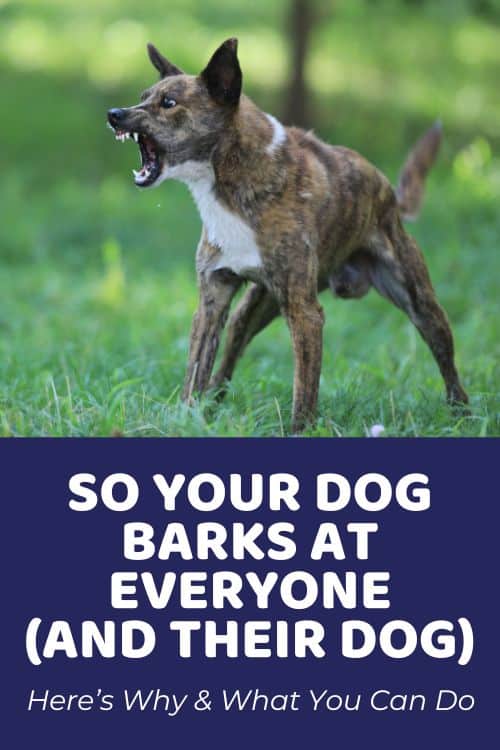A well-rounded Doodle is one that had plenty of early social contact. However, if, for some reason, your pup missed out on the critical socialization period, they may have gone on to develop some pretty bizarre behaviors around other dogs. Some of these may resemble aggression – whether or not that’s the intention. Either way, you don’t want other pet owners worried about letting their dogs near yours because they bark, lunge, or snap.
While earlier certainly is better when it comes to both socialization and training to establish more desirable behaviors, fear not! If you are having to start from scratch with an older hound, not all is lost. Eliminating these less attractive, aggressive-looking canine actions is just going to be a little harder, is all. Here we’ll take a look at how to socialize an aggressive dog safely, as well as what not to do when you’re teaching your dog how to behave around others.
Table of Contents
- What Exactly Is Meant By The Term “Aggressive Dog”?
- Key Reasons For Canine Aggression
- The Importance of Socializing An Aggressive Dog
- Measure To Take Before Beginning The Socialization Process
- How To Socialize An Aggressive Dog
- Should I Send My Aggressive Dog To Growl Classes?
- What To Avoid When Socializing An Aggressive Dog
- Frequently Asked Questions About Canine Aggression
What Exactly Is Meant By The Term “Aggressive Dog”?
First things first, dogs are very rarely aggressive by nature. Most present-day pups were selectively bred to be excellent companion animals. After all, violent dogs don’t make great pets. So, when considering canine aggression, it’s better to think in terms of your dog exhibiting aggression rather than being aggressive full stop. Labeling your dog as “aggressive” often prevents you from considering what may lie at the root of the behavior.
Many actions interpreted as aggressive (barking, snarking, snappy, etc.) actually signal that a dog is afraid of something and not angling for a fight. That’s why canine behavior experts tend to label these hounds as “reactive” rather than “aggressive.” In short, a dog perceived as acting in an aggressive manner is just reacting in an extreme way to something unfamiliar, or that seems scary to them. This we can do something about.
Key Reasons For Canine Aggression
Once we understand that fear lies at the root of most aggressive responses in dogs, we can start to consider what may be provoking this fear and this behavior. Often early trauma can make dogs anxious about specific stimuli or situations, even while they may seem more generally quite laid-back. Frequently you hear of rescue dogs being afraid of ‘men in hats,’ ‘larger dogs,’ or even ‘dogs of a specific color or breed,’ for instance. So if you adopted an older dog and don’t know much about their background, this could it.
However, if you adopted a seemingly well-adjusted puppy, it may be the case that something was lacking in their early socialization experience. There are many reasons this could happen… if you brought them up in a quiet household or a remote location, for example, you might not have been able to expose them to a full range of people, animals, and environments. In fact, under-socialization is a common issue in dogs today due to recent social restrictions and the resultant so-called “pandemic puppies.”
Ideally, puppies should be socialized right from birth, starting with their littermates, and then, once they have received the appropriate vaccinations, other dogs deemed puppy-safe, plus plenty of people, including children in various different settings. These early experiences help the puppies to be familiar and comfortable with a wide range of situations. They also shape their social behavior, making them better equipped to interpret social cues and respond accordingly.
Pups that never had such early experiences tend to be generally anxious about anything unfamiliar – strangers, new dogs, different environments… simply because it is part of a canine instinct to be fearful of the unknown. They will try to chase the object of their fear away. The more this kind of behavior works (the person or other dog keeps their distance), the more reinforced it will become. Plus, any sort of attention you give your pal when they do this will also encourage the response taking it from bad to worse.
The Importance of Socializing An Aggressive Dog
Dealing with an aggressive pet is never easy. In reality, it can be downright stressful for your dog and you too. You never know how they are going to respond; you are having to constantly apologize to people and dog owners… It may even get to the point where you wonder if it’s even worth trying to get your fur baby used to the presence of strangers and animals at all. You might think it’ll be easier all around if you just keep your distance.
The issue with that, however, is that dogs (much like us) are social creatures. They crave interactions with others. In fact, it’s crucial to their overall well-being to spend quality time in the company of other hounds (and people willing to fuss over them). Not giving your dog the chance to do this could lead to an onslaught of other undesirable behaviors, like chewing and barking, as they search out other ways to keep themselves entertained.
Measure To Take Before Beginning The Socialization Process
While it’s always good to be fully prepared before doing any type of training with your pooch, you will want to be REALLY ready to socialize a reactive dog. If you lead your hound into a situation they are not prepared for, someone could end up getting hurt. Dog fights can be fierce and frightening affairs that are extremely difficult for owners to break up. With this in mind, there are a few things to consider before you get going.
Take Care Of Your Dog’s Physical And Mental Health
If your canine companion is only recently acting aggressively, it may be the case that there is something physically wrong with them. Dogs in pain can warn and snap to keep people and other dogs away from the area causing them pain. Sickness can also have a pet to act more crotchety than normal. If you have recently switched foods, gastrointestinal issues could easily be to blame, for instance. Sadly, our pups can’t simply tell us when something is wrong, so a trip to the vet might be in order.
Beyond that, dogs can start to act up a bit when they are not getting enough physical or mental stimulation (or both). You might want to consider whether the demands of your life are getting in the way of being able to appropriately exercise or otherwise spend quality time with your pet. As super smart critters, Doodles are probably a little more demanding than other dogs. They need plenty of love, toys, games, grooming, walks, and fun to keep them happy and healthy.
Identity The Triggers
Usually, with a bit of experience, you can come to know your pup’s moods quite well, as well as the things that make them excited or afraid. Understanding whether they react badly to men, women, children, other dogs, other animals, strange objects, unfamiliar environments, or all of the above will give you a solid place to begin. If your pet is fearful of many things, chances are you’ll have to tackle these one at a time so as not to overwhelm them or increase their overall anxiety.
Stabilize Your Dog’s Mood
Body language often lets you get a good measure of your pup’s internal state, be it open and confident or hunched and upset. When stressed, they may also exhibit certain behaviors (aside from ones considered aggressive), such as yawning, restlessness, licking their lips, panting, and shaking their coat. These may seem very innocuous but could be the early signs that your pet is feeling uncomfortable with their present situation.
Aside from removing your dog from and keeping them from situations that have this effect, there are a few other measures you might try to calm their nerves. Various essential oils, for instance, are said to help with pet relaxation (as they do with people’s relaxation). Calming treats featuring the increasingly popular ingredients CBD and hemp may also be effective at making their mood a little more stable as you work at helping your pup overcome their issues.
Help Them To Feel Safe
If you have recently adopted a new pup, then it goes without saying that they may not yet feel comfortable in your home. However, certain household changes, including a move, new members being added to the family (children or other pets), building work, or people moving out, can also all impact your Dood, making them feel less safe and happy than they previously were in their environment. While little can be done about many of these, it’s good to be aware of their effect on your dog.
Keep your pet feeling secure through the ups and downs of a changing house or family life by keeping their routine as stable as possible. Feed them as close to the same time as you can each day, in the same spot, and exercise them around the same times too. Give your dog their own space (a crate or bed) to retreat to when needed. Dogs like to know what to expect from their day. By making their life as consistent as you can, you can reduce unwanted behaviors that arise due to this.
Practice Basic Obedience Commands
Before starting the socialization process, it’s good to work with your pup and teach them a few simple verbal commands like “sit,” “stay,” and “come.” Training not only serves to put these commands at your disposal when you are able to calm your dog enough that they will happily listen and respond to your requests, but it can also strengthen the bond between you. A trustful relationship will serve as an anchor that can help keep your canine calm in situations that otherwise might stress them out.
How To Socialize An Aggressive Dog
A careful program of desensitization and counter-conditioning is the very best way to socialize an aggressive dog. First, you will need to identify and tackle your pal’s fears by gradually exposing them to the stressful stimulus. Once they are able to maintain some degree of calm, you can work on teaching them more appropriate ways to behave. It goes without saying that the latter isn’t going to happen before you’ve mastered the former.
Here’s what to do:
Introduce Your Dog To Others In A Controlled Environment
While the local dog park is a great place to go to get your hound adjusted to seeing other people and dogs, it might not be the best place for tackling more up-close-and-personal desensitization training. A high-energy, multi-canine situation will quickly have your pooch feeling overstimulated, overwhelmed, and fearful. Instead, opt for a quiet, neutral location away from your home (to avoid territorial issues) where your pet feels comfortable.
Then, depending on the stimulus in question, you can start the process of getting your pup used to things. If your pal is anxious around people, you can start there by enlisting the help of a supportive, dog-loving friend. When looking to socialize your pet with other dogs, ask a friend with an easy-going pup to help. Either way, keep the trigger stimulus around 20 feet from your dog (while on their leash) to start with and gauge their response.
Follow a Carefully Set Out Socialization Routine
Once you have embarked on this type of training, you need to be doing it on a regular basis. A single day a week is unlikely to be sufficient to get your hound where you want them to be. As often as you can is best. Always approach the task in the same way, asking your friend (with or without their dog) to maintain the same distance. When you feel your Dood is comfortable, you can gradually move them forward – still on the leash.
The aim, at all times, is to keep your four-legged friend below the “threshold of reactivity.” They should be aware of the stimulus but not exhibit any kind of aggression towards it. If your dog is reacting, move them further and further away until you reach a place they are calm. Get them to sit, and try to keep their attention on you. Use high-value treats and plenty of attention and praise to reward your pup for doing what you want them to do.
Take It Slowly Introducing New Triggers After Much Practice
You may be keen to make quick progress. However, it’s so crucial that you don’t rush things when it comes to the desensitization process. Just because your pup doesn’t respond poorly to a stimulus one day doesn’t necessarily mean they won’t get the next. You may also find yourself taking backward steps, which can be incredibly frustrating. That’s why experts recommend staying on the same level for at least ten attempts before pushing progress on. In this way, you can be more confident in your pet’s behavior.
The good news is that you should see things speeding up as your hound gets the hang of the training and what’s expected of them. However, you might see a little “extinction” aggression as your pup works harder to try and get the stimulus to move it along. Deal with this calmly and with patience, and you’ll soon come out the other side. When you are able to bring your pal all the way up to the other person or dog, you can then start to bring in other triggers or explore different environments for this type of training.
Allow Your Dog To Participate in Social Activities
Providing your Dood with social contact (albeit from a distance at first) should be something you do alongside other training. The more ways you can safely do this, the better for your dog. In this way, they can start to get accustomed to multiple people, pups and environments, begin picking up social cues from both, and generally start interacting with others. Again, as you are doing this, be very aware of how your mutt is responding, and be prepared to move further away as needed.
During this time, get Fido to always pay close attention to you. Practice basic training commands and lavishly reward wanted behaviors. Once you feel confident that your pal is no longer triggered in the same way, you can cautiously start to let them physically interact with the other dogs. Keep them on a leash for this. If they are on the larger side or particularly energetic, a no-pull harness is a good idea. This will give you more control.
It goes without saying, though, that you should never put yourself in a situation where you feel you could get hurt. If your pup starts acting out, just get them out of there, and if a fight breaks out, make sure you never put your hands between your pet and another dog. The safest way to deal with a situation like this, if you can’t break them up with the leash, is by catching the dogs off guard with a loud noise or a jacket thrown over the both of them.
Talk To Your Vet Or A Professional Dog Trainer
If you have been working with your dog for a while to no effect, or if their aggressive behavior suddenly escalates, there is absolutely no shame in consulting with a professional. These kinds of problems are common in dogs of all kinds and backgrounds, and nobody is going to blame you for what’s going on with your pup. Instead, a behavior expert may be able to offer advice that’s more specific to your dog’s individual situation.
Should I Send My Aggressive Dog To Growl Classes?
Growl classes, usually better referred to these days as “training classes for aggressive dogs,” are intended to help dogs that act in an aggressive manner toward other dogs while being friendly toward all people. If you’re relatively new to dog ownership or lack confidence in dealing with some of your pooch’s more aggressive-seeming tendencies, these could be a great option for you. Just be aware that pups who act aggressively towards people won’t usually be accepted into one of these classes.
The benefits of these active workshops are that you and your pup get expert support with this vexing issue, and it’s another excellent opportunity to further their socialization. You’ll likely learn some excellent tips for helping your pet (and yourself) to remain calm even in more stressful circumstances. Just make sure to “vet” the classes thoroughly in advance, checking out the methods used, just what to expect when going there, and refer to reviews to understand the kind of results you might see.
What To Avoid When Socializing An Aggressive Dog
Canine aggression can often look pretty frightening, even to the owners. For this reason, it might be tough for you to keep your cool, yet keep your cool you must. If your hound senses any anxiety from you about a situation or behavior, it will only serve to add to theirs. In this way, they will conclude that the other person or dog is the threat they perceive them to be, and their actions will be that much worse.
Likewise, lashing out in any way – whether verbally or with your hands – is also not a good idea for much the same reasons. In fact, what could happen is that they could turn and start directing aggressive actions toward you. Once this has happened, you have lost your dog’s trust, and you will have to work hard on rebuilding this again before you can even hope to correct any of their aggression toward others.
Finally, avoid contraptions designed to restrict your pup in any way (aside from the regular leashes and harnesses, that is). Muzzles may seem like a good way to ensure no harm comes to anyone – human or canine, but they will be far more of a hindrance than a help. No dog likes being controlled this way, and it will likely just add to their fear. If you really are worried about your dog actually biting, you should be working with a professional.
Frequently Asked Questions About Canine Aggression
Actions interpreted by us people as aggressive generally indicate that your pet is fearful. If they haven’t had a lot of prior contact with other people – especially strangers – this may cause them to growl or show their teeth as a warning. They might see the person as being a threat and want them to go away.
Aggression can usually be reversed through a careful process of desensitization, which involves getting your hound to the point where they don’t react when in the company of a trigger, and counter-conditioning, where they learn new behaviors through the use of a reward-based system.
Dogs don’t tend to be aggressive by nature, just fearful. By avoiding situations to safely socialize your dog, you could be making the situation much worse. Pups react to the unknown. Thus the more familiar your pet is with other people and dogs, the calmer they will be around them. You just need to exercise a little extra caution and patience than other dog owners when doing this.
Most contemporary breeds have long been kept as companion animals, and for this reason, you rarely come across naturally aggressive dogs. That being said, some kinds of dogs have more recently been bred as fighting pups and have more of an inclination toward aggression. These include Pit Bull Terriers, Doberman Pinschers, and Rottweilers. However, in the right environment, even these dogs tend to be absolute teddy bears.
It goes without saying that the best way to reduce aggression in a dog is to remove them from the situation or environment that brought about the behavior. In terms of more general fearfulness, there are a few natural remedies that can help, including essential oils as well as hemp and CBD. These latter ingredients are becoming increasingly popular in canine calming treats.
Dealing with a dog seen by others as aggressive can be difficult. Obviously, you love your pet and want to do your very best for them. However, this can be made tricky by struggles such as the inability to walk them in the park without them going crazy at strangers and other dogs. Luckily, aggression in canines tends to be a behavior rather than a trait. This means that there is something to be done about it. A little gradual exposure to pain points and a lot of love could have your previously unhappy hound joyfully lolloping about with other dogs in no time at all.

